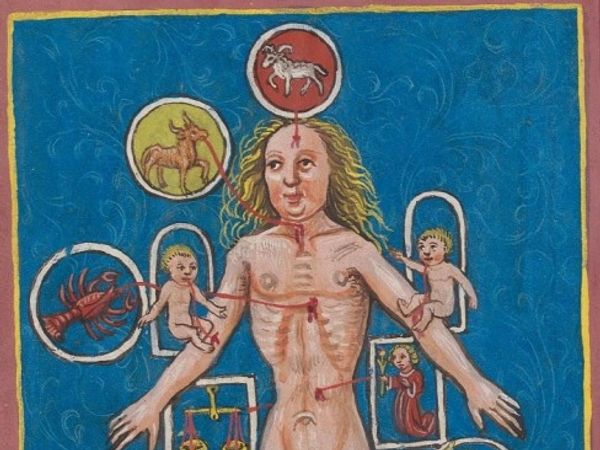
L'Homme Zodiacal
How Medieval Music Rebalanced Body and Cosmos
L’Homme Zodiacal explores the medieval belief that the human body mirrors the structure of the cosmos, governed by celestial forces, the four elements, and the humours. Centering music as a bridge between the harmony of the heavens and the inner balance of the body, the program highlights works from Hildegard von Bingen to the Ars Nova and Ars Subtilior traditions, revealing how sound was seen as both medicine and spiritual alignment. Performed on medieval instruments and interwoven with electronics, this immersive experience blends music, movement, and light to transport audiences into a world where proportion was sacred, the body reflected the stars, and every vibration resonated with cosmic order.

ROSE & FLAME
Desire in the Courts from the Troubadours to Machaut
Love and desire lie at the heart of the music and poetry of the troubadours (Occitan), trouvères (Old French), the minnesängers (German), and Guillaume Machaut. These medieval poet-musicians crafted refined and often idealized expression of love, intertwining passion with feudal and religious imagery. Their songs were primarily monophonic, allowing the poetic text to take center stage. The interplay between words and melody was essential - intricate verse forms and melodic contours deepened the emotional resonance of their works.

LE LIVRE ROUGE
Music of the Pilgrims of Montserrat
The Llibre Vermell de Montserrat ("The Red Book of Montserrat") is a 14th-century manuscript from the Benedictine monastery of Montserrat, Catalonia, named for its original red velvet binding. It was created as a devotional guide for pilgrims visiting the Shrine of the Virgin of Montserrat, featuring music, prayers, and rituals to enrich their veneration of the Black Madonna.
The manuscript contains ten significant medieval musical
compositions, blending sacred and secular traditions to enhance the spiritual experience.
FLORILEGIUM
Songs of Medieval England from 1150 to 1300
The musical traditions of the British Isles during the Middle Ages were a cultural tapestry shaped by various continental trends. Influenced by papal authority and the Viking and Norman invasions, English songs embraced a heritage of Latin, English and Anglo-Norman French. The songs presented in the program offer a rare glimpse into the vibrant musical culture in the British isles from 1150 to 1300. The influence of Celtic folk songs and dances, troubadour music, and plainchant is evident in these pieces, which often employ themes of nature and allegory.

VAGA FANCIULLA
Music of the Italian Ars Nova
The Ars Nova was a revolution that changed the face of musical
culture in the late Middle Ages. In the realm of secular song, rhythm fused with metrical texts originated a new style that utilized vernacular language and polyphony to sing about love. Coating poetic forms such as the ballad, the madrigal, and the caccia with sound and rhythm gave them a new life. This program is a presentation of the Ars Nova in Italy, featuring the works of Jacopo da Bologna, Giovanni da Firenze, Andrea Stefani, Magister Pietro, Francesco Landini, and Johannes Ciconia.
Across the Channel
English and French Music of the Hundred Years' War
In collaboration with Diapente Renaissance Quintet, this program explores the musical evolution in France and England from the 13th to the 15th century, spanning the tumultuous Hundred Years' War (1337–1453). Through sacred and secular compositions, we trace how political strife influenced musical innovation, from the intricate polyphony of the Ars Nova to the emergence of the Contenance Angloise.
Featuring works by Machaut, Dufay, and anonymous masters, the program contrasts French and English styles while revealing surprising exchanges between them. This journey through medieval soundscapes in France and England illuminates how conflict and culture intertwined, and how music transcended borders even in times of division.
This website uses cookies.
We use cookies to analyze website traffic and optimize your website experience. By accepting our use of cookies, your data will be aggregated with all other user data.